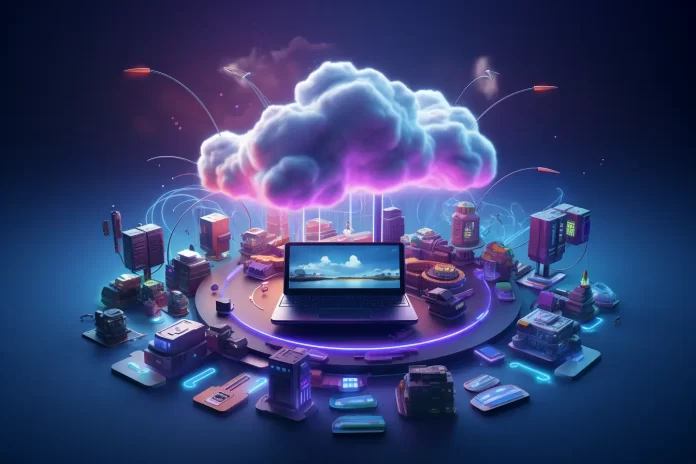Cloud gaming, also known as game streaming, is rapidly changing the landscape of the video game industry. By allowing players to stream games directly to their devices without the need for powerful hardware, cloud gaming is making high-quality gaming experiences more accessible than ever before. This article explores the rise of cloud gaming, its benefits and challenges, and what the future holds for game streaming services.
Read also about: The Evolution of Esports: From Niche Competition to Global Spectacle.
The Rise of Cloud Gaming
What is Cloud Gaming? Cloud gaming is a technology that allows users to play video games hosted on remote servers and streamed directly to a user’s device over the internet. Unlike traditional gaming, which requires powerful consoles or PCs, cloud gaming only needs a stable internet connection and a compatible device, such as a smartphone, tablet, or smart TV.
Key Players in the Market: Several major companies have entered the cloud gaming space, each offering unique platforms and services:
- Google Stadia: Launched in 2019, Stadia allows players to stream games in up to 4K resolution on various devices, including TVs, laptops, and smartphones.
- Microsoft Xbox Cloud Gaming (xCloud): Part of the Xbox Game Pass Ultimate subscription, xCloud enables users to stream a large library of Xbox games to mobile devices and PCs.
- NVIDIA GeForce NOW: This service lets players stream their existing library of PC games from platforms like Steam and Epic Games Store to various devices.
- Amazon Luna: Amazon’s cloud gaming service offers a selection of games via channels, with support for various devices and integration with Twitch.

Benefits of Cloud Gaming
Accessibility: One of the primary advantages of cloud gaming is its accessibility. Players no longer need to invest in expensive gaming hardware to enjoy the latest titles. As long as they have a stable internet connection, they can play high-quality games on a wide range of devices. This lowers the entry barrier for gaming and allows more people to experience high-end gaming without the associated costs.
Instant Play: Cloud gaming eliminates the need for lengthy downloads and installations. Players can start playing a game almost instantly after purchasing or selecting it from a subscription service. This convenience enhances the user experience and makes gaming more enjoyable and spontaneous.
Cross-Platform Play: Many cloud gaming services support cross-platform play, allowing users to switch between devices seamlessly. A game started on a smartphone can be continued on a laptop or smart TV, providing a flexible and cohesive gaming experience.
Game Preservation: With cloud gaming, game preservation becomes more feasible. As games are stored on remote servers, they are less likely to be lost or rendered unplayable due to hardware obsolescence. This ensures that classic games remain accessible to future generations of players.

Challenges of Cloud Gaming
Internet Dependency: The most significant challenge facing cloud gaming is its reliance on a stable and fast internet connection. High latency, bandwidth limitations, and inconsistent internet speeds can negatively impact the gaming experience, causing lag and reducing the overall quality of gameplay.
Data Privacy and Security: Storing game data on remote servers raises concerns about data privacy and security. Players must trust cloud gaming providers to protect their personal information and ensure that their gaming data is secure from cyber threats.
Subscription Costs: While cloud gaming can reduce the need for expensive hardware, the cost of subscription services can add up. Players might need to subscribe to multiple services to access all their favorite games, potentially making it more expensive than traditional gaming in the long run.
The Future of Cloud Gaming
Advancements in Technology: As internet infrastructure continues to improve, the challenges associated with cloud gaming are likely to diminish. Faster and more reliable internet connections, coupled with advancements in 5G technology, will enhance the performance and accessibility of cloud gaming services.
Expansion of Game Libraries: The future of cloud gaming will likely see the expansion of game libraries offered by streaming services. Partnerships between cloud gaming providers and game developers will ensure that more titles are available for streaming, giving players a broader selection of games to choose from.
Integration with Other Technologies: Cloud gaming will increasingly integrate with other emerging technologies, such as virtual reality (VR) and augmented reality (AR). This integration will create even more immersive and interactive gaming experiences, attracting a wider audience to cloud gaming platforms.
Market Competition: As more companies enter the cloud gaming market, competition will drive innovation and improve services. Players can expect better performance, more features, and lower prices as providers strive to attract and retain customers.
Conclusion
Cloud gaming is poised to revolutionize the gaming industry by making high-quality gaming experiences more accessible and convenient. While there are challenges to overcome, the benefits of cloud gaming are significant, and the future looks promising. As technology advances and more players embrace game streaming services, cloud gaming will become an integral part of the gaming landscape, offering exciting possibilities for gamers worldwide.
